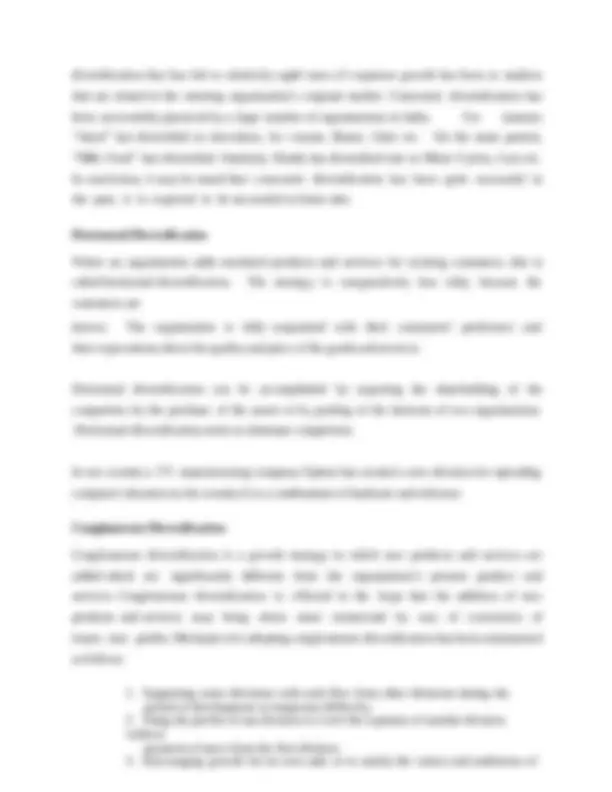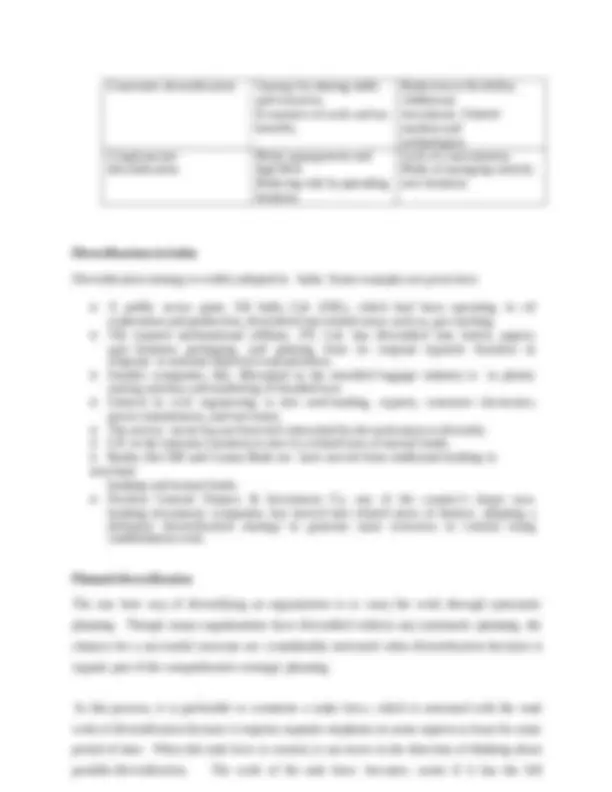











Study with the several resources on Docsity

Earn points by helping other students or get them with a premium plan


Prepare for your exams
Study with the several resources on Docsity

Earn points to download
Earn points by helping other students or get them with a premium plan
Community
Ask the community for help and clear up your study doubts
Discover the best universities in your country according to Docsity users
Free resources
Download our free guides on studying techniques, anxiety management strategies, and thesis advice from Docsity tutors
Introduction, Diversification, Growth Strategy, Core Business, Either Differentiate Or Diversify, Technology, Good Competitive Strategy, Concentric Horizontal, Distribution Channels, Accounting, Diversification, Horizontal Diversification, Abnormal Economic Situation, Prescription Drugs, Surgical, Accuvue Contact Lenses, Fasteners, Transport, Swot, Diversify
Typology: Study notes
1 / 17

This page cannot be seen from the preview
Don't miss anything!










Introduction
Diversification is one of the grand strategies, which basically is a growth strategy. Basically diversification involves a substantial change the business definition in terms of product range, customers or alternative technologies. Diversification strategies have been adopted a number of business groups and individual companies both in the public and private sectors. In the 1960 s and 1970 s, the trend was to diversify so as not to be dependent on any single industry, but the 1980s saw a general reversal of that thinking. Overall, diversification strategies are becoming less popular as organizations are finding it more difficult to manage diverse business activities. Diversification is now on the retreat. Michael Porter of the Harvard Business School says, “Management fount [it] couldn’t manage the beast.” Hence, businesses are selling or closing, less profitable divisions in order to focus on core business.
Why diversify?
Organizations diversify due to the following reasons. Some of the common reasons are as follows.
Synergy Synergy is cited in the most common cause of diversification. Synergy occurs when two or more activities produce their combined effect greater than the sum of its parts i.e., 2 + 2 = More than 4. o Related diversification produces synergies rooted in production technology. With the additional technical facilities, a by-product or joint product may be produced. o Both related and unrelated enable the companies to sell the products with same distribution network and advertisement facilities. The advertisement of one product spontaneously advertises other products with enhanced brand loyalty. This is marketing synergy. o Synergetic effect can also be noticed in financial operations, when the positive cash flow of one business utilized in other business helps to generate more positive cash flows.
Spreading of Risk. Diversification helps to avoid over dependence on one product/market. It spreads the risk associated with one product line or few products. Better opportunities. With diversification, company can exploit the better opportunities in new product line. Every product has it own product life cycle. To gain better market share, company has to either differentiate or diversify. Better utilization of Resources. With diversification, company can better use
hitherto unexploited resources like finance, market channels, production facilities,
technological
diversification that has led to relatively rapid rates of corporate growth has been to markets
that are related to the entering organization’s original market. Concentric diversification has
been successfully practiced by a large number of organizations in India. For instance
“Amul” has diversified in chocolates, Ice creams, Butter, Ghee etc. On the same pattern,
“Milk Food” has diversified. Similarly, Honda has diversified into to Motor Cycles, Cars etc.
In conclusion, it may be stated that concentric diversification has been quite successful in
the past; it is expected to be successful in future also.
Horizontal Diversification
Where an organization adds unrelated products and services for existing customers, this is
called horizontal diversification. The strategy is comparatively less risky because the
customers are
known. The organization is fully acquainted with their consumers’ preference and
their expectations about the quality and price of the goods and services.
Horizontal diversification can be accomplished by acquiring the shareholding of the
competitor, by the purchase of the assets or by pooling of the interests of two organizations.
.Horizontal diversification seeks to eliminate competitors.
In our country a T.V. manufacturing company Uptron has created a new division for spreading
computer education in the country.It is a combination of hardware and software.
Conglomerate Diversification
Conglomerate diversification is a growth strategy in which new products and services are
added which are significantly different from the organization’s present product and
services. Conglomerate diversification is effected in the hope that the addition of new
products and services may bring about some turnaround by way of conversion of
losses into profits. Mechanics for adopting conglomerate diversification has been summarized
as follows:
management or the owners.
o Duracell batteries. JOHNSON & JOHNSON o Baby products (powder, shampoo, oil, lotion) o Band-Aids and other first-aid products o Women’s health and personal care products (Stay free, Carefree, Sure & Natural) o Neutrogena and Aveeno skin care products o Nonprescription drugs (Tylenol, Motrin, pepcid AC, Mylanta, Monistat) o Prescription drugs o Prosthetic and other medical devices o Surgical and hospital products o Accuvue contact lenses
PEPSICO o Soft drinks (Pepsi, Diet Pepsi, Pepsi One, Mountain Dew, Mug, Slice) o Fruit juices (Tropicana and Dole) o Sports drinks (Gatorade) o Other beverages (Aquafina bottled water, SoBe, Lipton ready-to-drink tea, Frappucino-in partnership with Starbucks, international sales of 7UP) o Snacks foods (Fritos, Lay’s Ruffles, Doritos, Tostitos, Santitas, Smart Food, Rold Gold pretzels, Chee-tos, Grandma’s cookies, Sun Chips, Cracker jack, Frito-Lay dips and salsas) o Cereals, rice, and breakfast products (Quaker oatmeal, Cap’n Crunch, Life, Rice- A-Roni, Quaker rice cakes, Aunt Jemina mixes and syrups, Quaker grits)
Examples of companies that have diversified into unrelated business.
o Theme^ parks o Disney Cruise Line o Resort properties o Move, video, and theatrical productions (for both children and adults) o Television broadcasting (ABC, Disney Channel, Toon Disney, Classic Sports, Network, EPSN and EPSN2, E!, Lifetime, and A&E networks) o Radio broadcasting (Disney Radio) o Musical recordings and sales of animation art
o Anaheim Angles major league baseball franchise ( 25 percent ownership) o Books and magazine publishing o Interactive software and Internet sites o The Disney Store retail shops. THE TVS GROUP o Auto & auto parts o Coach body building o Transport o Fasteners o Brake linings & clutch facings o A citation systems for commercial vehicles o Hire purchase o Wheel structure & parts o Foundation brakes o Two wheelers o Automobile electrical parts o Tyres & tubes.
Advantages and disadvantages of diversification
A company planning to diversification should define its business, conduct SWOT analysis,
Risk analysis, competition and Gap analysis and also assess the advantages and
disadvantages of diversification. The following Table 1 1- 1 briefly outlines the advantages
and disadvantages of different types of diversification.
Table 11 - 1 Advantages and disadvantages of diversification strategies
Diversification strategy Advantages Disadvantages Horizontal integration Eliminates competitors. Access to new markets.
Less flexibility. Increasing risk and commitment.
support of top management. The role of this task force may be to collect and analyze
relevant information, which helps in arriving at diversification decision.
The basic problem in a diversification strategy is to identify the suitable industry sector,
which meets basic criteria of diversification. Figure 1 1- 1 presents a
process thorough which identification of diversification opportunities becomes systematic.
The process provides the facility for assessing and
measuring each business sector against a number of different criteria so that judgment can be
reached on two separate factors.
o Attractiveness of the sector as an investment in its own right and o The extent to which the qualities required for success in the sector match the own strengths of the organization.
There are basically three major measurements involved in this process.
o Measurements of industry attractiveness,
o Measurement of mesh, and Combination of attractiveness and mesh to arrive at some strategic alternatives
Figure11-1 Process for identifying diversification opportunities
Organizational objectives and strengths
Industry
Define broad initial criteria
Select sector meeting broad initial criteria
Place sector on attractiveness/mesh matrix
Assess mesh
Assess sector attractiveness
(i) Assessment of industry Attractiveness
Define alternative
Select industry sector
A (^) strategies ctors of the industry (^) for entry g diversification
opportunities. Such criteria may be in the form of:
(i) Acceptable product groups or functions, (ii) Minimum sales volume within a specified period of time, say five years or so, (iii) Minimum projected growth rate in the market (iv) Minimum profitability criteria, (v) Maximum and minimum investment required in the project, and so on.
can be taken for identifyin t the initial stage, various se
Maturity level Scores Ageing 0 Late mature 2 Early mature 4 Late growth 6 Growth 8 Early growth 10
Adding the scores for profitability to the sector maturity arrives at the scoring for over all attractiveness of each sector.
(ii) Assessment of Degree Mesh
Degree of mesh suggests the extent to which a particular organization can match the
requirements of an industry sector. It is assess on the basis of organizational strengths and
critical success factors (CSFs) required for success in the industry sector. CSFs are those
characteristics, conditions, or variables that when properly sustained, maintained, or managed
can have a significant impact on the success of an organization competing in a particular
industry. From the structure and maturity of sector, certain general conclusions can be drawn
on CSFs and its investment characteristics.
Taking both the factors-organizational strengths and CSFs, mesh matrix can be constructed as depicted in Figure 1 1-2.
Importance of CSFs
Excellent High Medium Low Figure 11 - 2 Mesh Matrix
High in the matrix will increase the upside pote investment because o the organization can add something to the operation of the new business, and o will decrease the downside risk because the management will have experience of the sort of problems that are likely to occur.
(iii) Combination of Attractiveness and Mesh Having rated each sector’s attractiveness and mesh, we can combine both to form another matrix. Because two measures are independent of each other, we can expect some sectors to score high on attractiveness but low on mesh whereas other sectors score low on attractiveness and high on mesh. The attractiveness/mesh matrix has been presented in Figure 11 - 3 below
According to this matrix, best diversification opportunities are those that score high on both characteristics having score of 9 ; least proffered is with low degree of both characteristics having score of 1. The selection of sectors from elsewhere depends on the strategy the organization selects.
score ntial of
rg
ani
za
tion
al
s
tr
engths
Critical (4)
High (3)
Medium (2)
Low (1) (4) 16 12 8 4 (3) 12 9 6 3 (2) 8 6 4 2 (1) 4 3 2 1
o When it can expand into industries whose technologies and products complement its present business. o When it can leverage existing competencies and capabilities by expanding into businesses where these same resource strengths are valuable competitive assets. o When diversifying into closely related businesses open new avenues for reducing costs. o When it has a powerful and well-known brand name that can be transferred to the products of other businesses.
When not diversify?
All the organizations cannot think of diversification as a strategy. Organizations do not diversify under the following conditions.
Summary o When they are small and cannot afford to try o When they have no power to sustain o When they anticipate some pitfalls o When they are the first to bell the cat in that area. o When on checking they find their functional skills are insufficient to diversify o When they don’t want to gamble with public investments o When they do not have attractive tax benefits after diversification
Pursuing a single-or dominant-business may be preferable to seeking a more diversified
business strategy, unless a corporation can develop competitive advantage. The primary
reasons for diversification are value creation through economies of scope, financial
economies, or market power; some actions are taken because of government policy,
performance problems, uncertainties about future cash flow, or managerial motivations (e.g.
to increase compensation). Managerial motives to diversify can lead to over diversification.
On the other hand, managers can also be good stewards of the firm’s assets.
The level of a firm’s diversification is a function of the incentives the firm has to diversify,
its resources, and the managerial movies to diversity. Related diversification can create
value by sharing activities of transferring core competencies. Sharing activities usually
involves sharing tangible resources between businesses. Transferring core competencies
involves transferring the core competencies developed in one business to another
business. Efficiently
allocating resources or restructuring a target firm’s assets and placing them under
rigorous financial controls accomplish successful unrelated diversification.